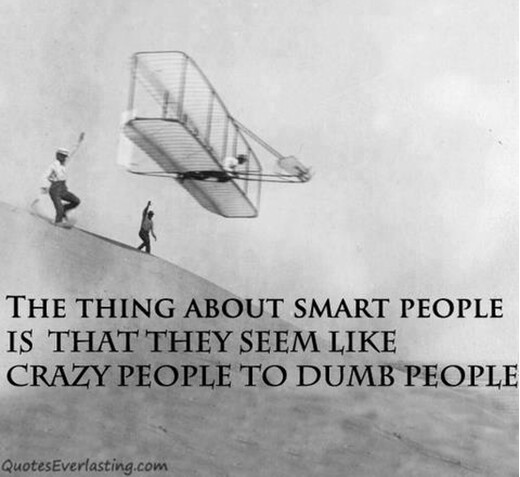Not too long ago, I  watching a series on PBS about the Seven Deadly Sins (Wrath, Pride, Envy, Greed, Sloth, Lust and Gluttony) and things started churning in my mind. So I decided to list my “Seven Deadly Sins of Marketing,” given what I continue to see taking place within marketing and marketing departments across all different industries.
watching a series on PBS about the Seven Deadly Sins (Wrath, Pride, Envy, Greed, Sloth, Lust and Gluttony) and things started churning in my mind. So I decided to list my “Seven Deadly Sins of Marketing,” given what I continue to see taking place within marketing and marketing departments across all different industries.
Guessing
In the Dilbert cartoon series, Dilbert says that “marketing is just liquor and guessing.” Funny…but as we know, a bit simplistic. Yet, too many companies assume that there is absolutely no need to substantiate their beliefs about the marketplace, about what their prospects want, about why their customers are buying, about what people think of their brand, about most anything having to do with those whom they want to purchase their products or services. Generally the thinking is that no one can know the marketplace as well as the company and the market will accept whatever you offer. Guess (pun intended) how that turned out for Kodak, Borders Books, TWA, and certainly some companies in your own industry! Ask yourself, when was the last time that your company committed the time and resources to do some marketing research…qualitative, quantitative, ethnographic, etc. And do it right.
Marketing by Committee (Indecisiveness)
I’m not sure why, but when it comes to marketing, everyone seems to have a say. Partners, staff, associates, spouses, and the janitor all want to give their two-cents. How about an accounting committee to help figure out where the credits and debits are posted? Or an office supply committee to pick out the colors of pens you order? Many executives forget that great marketing is not about what they like. Great marketing is about what works.
Committees, by nature, are full of compromises so solutions are usually watered down versions that will wind up doing little or nothing to accomplish your growth goals. Marketing by committee leads to lots of bad ideas and poorly thought out plans. Instead of bold strokes from the marketing brush, you get a sea of beige. And then it doesn’t work. Who would have thunk it! The solution is to decide on objectives and budget, and then write a marketing plan. Once the plan is approved, ONE person gets appointed within the organization to take on the role as “the decider.” Empower him or her to make all the courageous decisions required to position your company to dominate your category.
Inconsistency
When different aspects of your marketing messages don’t reinforce each other, the inconsistencies alienate prospects and current customers. Inconsistent marketing distorts clear expectations, makes potential customers unsure of the characteristics of your products and creates unhappy customers who don’t get what they expect. These inconsistencies affect businesses by reducing both initial sales to consumers as well as repeat sales from dissatisfied customers. Also, be consistent with your marketing plan. Don’t stop running an ad, for instance, just because the first insertion didn’t ring your phone off the hook. Give your campaign time to work, but you also need to know when a change in direction is a good idea. Remember, people are not paying that much attention to you, but when they do, it helps if the message you’re saying now is similar to the message that they heard the last time.
Complacency
It’s out there right now. Lurking in the shadows of your success. It is the silent business killer that strikes without warning and can bring even the biggest and the brightest companies to their knees. What is this hidden terror? Complacency. We all know it better as the dreaded “status-quo.” It generally takes the form of “whatever we did last year.” Except, things change. Your competitors are changing things up. Your customer’s needs are changing. The marketplace is changing. A few things to avoid complacency: Keep looking in your rearview mirror to see what your competitors are doing. Listen to new ideas as the next big idea may not come out of your own mouth. And, strive to always do better even before you are forced to react to a competitor’s challenge.
Lack of Focus
Okay, so after reading articles by “experts” about how you should have a customer engagement program in place (so you can be more “customer-centric”), you’ve put your company on LinkedIn, YouTube, Facebook, Twitter, Google+, and Pinterest. Heck, you’re even ready to go when the next big social media platform launches. You’ve got your product literature online, and your Web site has a blog and videos. Not to mention all the offline activities ranging from tradeshow activities to advertising to PR, etc. But why did you believe you needed to be in ALL of these social media locations in the first place, and, just as importantly, who is making sure that all of these activities work together?
Narcissism
It’s ridiculous that I have to say this but the memo has not reached the desk of many marketers, so here goes: “It’s not about what your company wants to say but rather about what the customer wants to hear.” (I feel better having said it.) Look, if you want to market based on your personal preferences without regard for what works best with your prospects, that’s your prerogative. But I’d suggest that your company’s marketing not be so self-absorbed. Remember, you don’t buy from you, others buy from you and they don’t care about your business and your troubles nearly as much as you do. Most people are tuned into Radio Station W.I.I.F.M. —“What’s In It For Me!” If your marketing message is all about you, then your customers won’t notice what you’re saying. Please begin to “tune” into your customers, find out what they really want and focus your message on them.
Confusion
Maybe, just maybe, the deadliest marketing sin of all is not having one over-arching marketing strategy – and insuring its implementation through all your tactics. Executing marketing tactics without having a well-developed integrated strategy is like leaving your roadmap tools at home and taking off on the drive without considering if you’ve chosen the right road. You wouldn’t haphazardly set off on an important trip in your car so why let it happen with regard to your company’s marketing activities. It’s easy to start with the “how” but if you haven’t identified the “what,” you may find yourself spending a lot of time executing tactics that don’t take you where you want to go and in so doing, you’ll be wasting time, resources and losing out on sales-producing opportunities. What is needed is one single integrated strategy that looks across all delivery platforms whether online or offline, print, broadcast, or mobile. Your customers don’t have an online self and offline self and neither should you. Think holistically about all your marketing initiatives.
Yes, there are more Deadly Sins that I could have talked about, like trying to be a “do-it-yourselfer,” or not measuring your activities, or saving yourself into bankruptcy, but the above are the Seven Marketing Sins I rank topmost. Now, let us all go out and to the best of our ability, sin no more.
####
Rolf Gutknecht is vice president, director of account services for LA ads. To discuss your thoughts with Rolf on this blog or any marketing matters, email via this link, or visit www.LAadsMarketing.com. You can also connect with Rolf on LinkedIn.
As we all know, Pinterest and Instagram have become staples on the social media scene. The right visuals (from photos to quotes to inspirational messages) have great appeal and serve as motivation for many. With that in mind, here are some interesting visuals coupled with some content concerning marketing issues that face marketing teams almost daily as they work towards creating the change in the way people use and interact with their company’s products or services. Short, sweet and fun. Click away! 
The average attention span today is roughly 9 seconds…like that of a goldfish. Nine seconds to communicate a message, earn a little bit of loyalty, build a little bit of trust so you can continue the conversation before your customer starts getting distracted! So what could you possibly say in that time or less to get someone’s attention? It starts with presenting your message in clever and unexpected ways. It grabs people’s attention and has them focusing on the message and not thinking about the other stuff that could come into their mind. They’re engaged and captivated. In doing so, it allows you to persuade them, get them to trust you, get them to believe you, get them to want to connect with you. A shift in perspective from speaking about yourself to speaking from the audience’s point of view can be remarkably effective. Witness a beautiful commercial for a British online content company featuring a blind man whose original cardboard sign talks about himself, “I’m blind. Please help.” But when a caring passer-by changes the words to be more audience-focused, something powerful happens. The symbolism is powerful. To read more, click here.
Social media as a pathway to sales is almost certainly not going to work to the degree you want. There…I said it. While social media can be a valuable marketing tool, it’s not magic and it cannot and won’t replace everything that came before it. There’s no quick success and very few programs break through. Coca-Cola says it can find no correlation between “buzz” on Twitter and actual unit sales. Nissan admits it has no idea if social media helps it shift cars. MasterCard can’t tie its social investment to revenues. Don’t take my word for this. Go online and do your own research and see for yourself. In fact, there remains little evidence social media does anything to boost brands’ bottom lines. So then why use social media at all? The reason is that it is an impactful vehicle for empowering advocacy and we know that’s extremely important for brand health and profitability. Social media, if done right, can capitalize on what brand equity your company has already built up. To read more, click here.
 When was the last time you/your marketing team asked the question “I wonder what would happen if we ________.”Crazy ideas have changed the way we go about living our lives. Knowing this, why is it that many marketers still don’t trust the crazy idea when it shows up unexpectedly especially, since crazy ideas, not safe ideas, are the game changers that propel companies forward? In today’s competitive, me-too world, if your product isn’t a legitimate leader in a category, it’s certainly a far better choice to come up with a new value story around your own product or service rather than trying to compete price-wise on the value that was generated by a competitor. You might want to be thinking about a crazy idea that will create a new meaning around your brand. Embrace that mindset so much so that the next time an idea is presented by your marketing department and someone outside of that department says “That’s a crazy idea,” you’ll say, “Thanks, we love it as well!” To read more, click here.
When was the last time you/your marketing team asked the question “I wonder what would happen if we ________.”Crazy ideas have changed the way we go about living our lives. Knowing this, why is it that many marketers still don’t trust the crazy idea when it shows up unexpectedly especially, since crazy ideas, not safe ideas, are the game changers that propel companies forward? In today’s competitive, me-too world, if your product isn’t a legitimate leader in a category, it’s certainly a far better choice to come up with a new value story around your own product or service rather than trying to compete price-wise on the value that was generated by a competitor. You might want to be thinking about a crazy idea that will create a new meaning around your brand. Embrace that mindset so much so that the next time an idea is presented by your marketing department and someone outside of that department says “That’s a crazy idea,” you’ll say, “Thanks, we love it as well!” To read more, click here.
If you want to have passionate customers and dedicated partners, you must first inspire strong responses. But as you attract fans, you’re also bound to get the critics or “Haters.” It’s OK to have some folks (not too many, though) who will not like your brand. The undeniable reality is that if you’re not eliciting a negative response from someone somewhere, then you’re probably not that fascinating to anyone. Think about it, even Apple has Haters as does Starbucks and it hasn’t hurt them. Alternatively, you have the advocates, evangelists, loyalist…the Lovers. They don’t just buy your product or service, they also accept price increases and forgive occasional “issues.” They’re loyal and not just buying your products for price or utility. In the middle are the Lukewarmers. They have a really bad habit of not caring. They won’t buy your product unless it’s the cheapest or most convenient option which means they’re only buying you until a cheaper or more convenient alternative comes around. In today’s marketplace, this middle ground is death!! Not caring is not buying. Not caring is inaction. The world is not changed by people who sort of care or don’t care at all. Stop focusing on the Lukewarmer. Start by having your marketing and advertising be imaginative, original and fresh. To read more, click here.
Having dealt with all sorts of companies and people, I believe the Number One reason for boring “vanilla” marketing messages is the result of trying to please all the people all the time. Fighting the desire to be all things to all people lets you: 1. Stand out from the herd; 2) Attract the like-minded; and 3) Create stronger connections. Vanilla brands might not have enemies, but they also don’t have passionate advocates whose enthusiasm spreads. In order to win the race, you can’t stand still. Vanilla marketing is standing still. To stand out, to be different, to be memorable, takes boldness. It takes being “a real Marketer”. So, however you go about it, stop defaulting to dishing out plain vanilla marketing and start scooping out interesting flavors (think “Cherry Garcia”; “Chubby Hubby”; or “Chunky Monkey”, etc.) that stand out and are uniquely your own. To read more, click here.
So there you have it. 5 visuals that speak to different marketing challenges and opportunities. Maybe these visuals will stick with you for awhile and even change the way that certain projects, campaigns and programs are developed and executed. Seeing is believing.
####
Rolf Gutknecht is vice president, director of account services for LA ads. To discuss your thoughts with Rolf on this blog or any marketing matters, email via this link, or visit www.LAadsMarketing.com. You can also connect with Rolf on LinkedIn.
 While driving in my car the other day, I was thinking about the recent Mazda TV commercials featuring people that invented something that we commonly use in today’s world. Suddenly, I blurted out something that had me stumped by my own question: “Where do all the crazy breakthrough ideas come from?” And when I say “crazy”, I mean crazy as in unexpected… revolutionary…the WOW kind. Well, after doing some quick online research, it turns out that “formless thought (the stuff that just pops into your head) in a creative mind” is where “crazy” ideas originate from.
While driving in my car the other day, I was thinking about the recent Mazda TV commercials featuring people that invented something that we commonly use in today’s world. Suddenly, I blurted out something that had me stumped by my own question: “Where do all the crazy breakthrough ideas come from?” And when I say “crazy”, I mean crazy as in unexpected… revolutionary…the WOW kind. Well, after doing some quick online research, it turns out that “formless thought (the stuff that just pops into your head) in a creative mind” is where “crazy” ideas originate from.
Many of the products that we can’t seem to live without today started out as crazy ideas – ask the Wright Brothers or Henry Ford or Bill Gates or Steve Jobs or the “Mazda Guys” like Bill Simpson – inventor of flame-resistant racing suits or Martin Cooper – inventor of the mobile phone. Or Netflix, Costco and so on. At the time, it was stuff that nobody needed or was asking for (maybe because people didn’t see a problem that needed fixing), but once developed, it was just the thing that people were waiting for. And each idea proved to be a big success in the marketplace. These crazy ideas have changed the way we go about living our lives and it all started as a formless thought. Knowing this, why is it that many marketers still don’t trust the crazy idea when it shows up unexpectedly especially, since crazy ideas, not safe ideas, are the game changers that propel companies forward. On the other hand, safe ideas are the ones you can more easily assume will work before it takes form in the world. (Note: That said, I’ve never quite understood the concept of guaranteeing a new idea will take hold in the marketplace before it actually gets produced, introduced and marketed. With so many factors involved in making that happen, who can do that?)
In some ways, I think crazy ideas are like the ancient fire that early humans feared until proven helpful. Once these humans first learned that fire made life a lot easier – from staying warm to cooking meat – the idea spread like wildfire (pun intended) and was widely accepted as necessary for a more comfortable survival and not something to avoid at all costs. I believe crazy ideas are like that as well.
In today’s competitive, me-too world, if your product isn’t a legitimate leader in a category, it’s certainly a far better choice to come up with new value story around your own product or service rather than trying to compete price-wise on the value that was generated by a competitor, right? So, if you do find your company ranked 3, 4 or lower in your industry, you might want to be thinking about a crazy idea that will create a new meaning around your brand. Think of it like a “Blue Ocean” strategy.
Two examples come to mind…LA Gear (athletic shoe brand-late 80’s) and Swatch (watches).
In both of these cases, as their larger competitors were keeping an eye on consumer needs related to performance features, both LA Gear and Swatch had the crazy idea that people, and lots of them, were more interested in how they expressed their own personality and style, and these people were willing to pay more for products that helped them do it. In the minds of the customer, these products functionally did what competitive products did…but these products also spoke to them on another level. And in doing so, these two “crazy” companies each created a new category and a competitive advantage that they had all to themselves.
OK, so now what? Well, from where I sit, if your brand/product/service is to prosper in a world that’s driven by the daily creation of crazy new ideas, your company will need to choose whether their marketing department, and their activities, will operate from a creative platform or competitive platform.
When your company operates from a competitive platform, it can only win by having somebody else lose, similar in look to that of a “Red Ocean” strategy. Here companies try to outperform their rivals to grab a greater share of product or service demand. As a result, crazy ideas that are formless and unproven will be quickly be dismissed in favor of the known and the “proven.” Typically the marketing messaging and activities for companies operating from a competitive platform are uninspiring, forgettable, and 2nd tier level within their specific industries. They’re totally devoid of connecting with the customer on an emotional, human-to-human level in part because BIG data has played a huge role in the product coming to market. These messages don’t even register a blip on your consciousness radar screen…they’re that uninspiring.
Alternatively, if your organization operates on the creative plane, it will have a compelling reason for being. It will develop products that redefine the category, fascinating customers with the unexpected, making competition and pricing (in most cases) irrelevant. It’s the type of organization where people don’t settle for the status quo and find “crazy ways” to fill in the blank part of the question, “I wonder what would happen if we ________.” In the movie rental business, “What would happen if we didn’t charge late fees?” Thus, Netflix. In retail, “What would happen if we sold quality products in larger/bulk quantities at the lowest possible prices?” Viola: Costco. This creative plane is where so-called crazy marketing ideas are constantly brought to the forefront for consideration. Where non-traditional thinking isn’t immediately shot down because it doesn’t conform to the “we just don’t do it that way” type of thinking. It’s where your competitors say “why didn’t we think of doing or saying it that way?”
Let me ask you a question: What will your company innovate or creatively say in 2014 that will differentiate your business by bringing higher value to your customer base? My vote would be to get crazy, to break away from commonplace. Embrace that mindset so much so that the next time an idea is presented by your marketing department and someone outside of that department says “That’s a crazy idea,” you’ll say, “Thanks, we love it as well.”
####
Rolf Gutknecht is vice president, director of account services for LA ads. To discuss your thoughts with Rolf on this blog or any marketing matters, email via this link, or visit www.LAadsMarketing.com. You can also connect with Rolf on LinkedIn.
 Oh, the wonder of beautifully crafted taglines. Those few strategically selected words that sum up everything your business stands for and what you want your target audience to know about you. They’ve made companies fortunes by telling people what makes them standout in the sea of sameness. Consider FedEx’s brilliant “When it absolutely, positively has to be there overnight.” Nine simple words that tell FedEx buyers precisely what they’re going to get, while simultaneously informing all of its employees what their mission is. What if FedEx’s slogan was “We ship things!”? Would Nike be as successful if it allowed an executive committee to red-pencil “Just do it” into “When you need great shoes”? How would BMW’s vision change if “The Ultimate Driving Machine” became “Our cars are fun to drive!” My point is that these companies didn’t settle for weak platitudes or vague, generalized statements that could have applied to their competitors. Nope, they decided that they weren’t going to settle. Instead standing out and differentiating themselves was business-critical. Can the same be said for your company and its marketing? Do you have a themeline or slogan that makes you stand out? Is it unique and memorable? Or is it mediocre because somewhere down the line, people settled?
Oh, the wonder of beautifully crafted taglines. Those few strategically selected words that sum up everything your business stands for and what you want your target audience to know about you. They’ve made companies fortunes by telling people what makes them standout in the sea of sameness. Consider FedEx’s brilliant “When it absolutely, positively has to be there overnight.” Nine simple words that tell FedEx buyers precisely what they’re going to get, while simultaneously informing all of its employees what their mission is. What if FedEx’s slogan was “We ship things!”? Would Nike be as successful if it allowed an executive committee to red-pencil “Just do it” into “When you need great shoes”? How would BMW’s vision change if “The Ultimate Driving Machine” became “Our cars are fun to drive!” My point is that these companies didn’t settle for weak platitudes or vague, generalized statements that could have applied to their competitors. Nope, they decided that they weren’t going to settle. Instead standing out and differentiating themselves was business-critical. Can the same be said for your company and its marketing? Do you have a themeline or slogan that makes you stand out? Is it unique and memorable? Or is it mediocre because somewhere down the line, people settled?
Let’s face it, we have a tendency to settle. It’s almost human nature. We settle for something that’s not just quite right, an outfit that isn’t our best look, a job that doesn’t maximize our talents or an ad or website page that’s okay or just “good enough.” While the act of compromise in life, relationships and particularly conflict is an admirable trait, compromise or “settling for” in marketing is a death knell.
You see, the whole point of your marketing activities is to get noticed; get engaged with your audience; and have your work be acted upon to bring in the business. Alternatively, anonymity, swimming in the center of a school of other fish, may be a good survival tactic if you are an anchovy, but it is not a good survival tactic for business. So you have to wonder why so much marketing – and so many marketers – feel the need to play “follow the leader” with respect to marketing trends.
The logic is that if others have done something successfully, you just need to do the same thing. Well, maybe. And then again, maybe not. As we all know, breakthrough products and breakthrough marketing campaigns are not achieved through conformity. Note the word “break” in breakthrough. These are the products and campaigns that break the rules. These are the products and campaigns that use insight, intuition, experience, sensitivity to the marketplace – and arguably the most important thing….courage – to do things differently. To break away from the status quo.
It is certainly true that most companies don’t have that innate insight and courage to be successfully different. We can’t all be like Steve Jobs. But for those are willing to do things differently and well, for those who want their companies to stand out, then the only rule that matters is: You cannot achieve exceptional success through conformity.
To that end, you can have your brand and product/service stand out if you’re willing to take a risk. For starters, ask yourself these three questions:
1. What’s can you say about your company that’s seen as a unique or fresh alternative to your competitors? This can range from the product or service you offer to the way you do business to that of sharing your wisdom. Think beyond the obvious. Dig deeper. Ask yourself a bunch of “So what does that mean?” and “Why would our customer care?” with each answer that’s given.
2. What medium makes the most sense for your brand? The goal is to create a campaign that drives conversation and ultimately revenue. So what imaginative or different ways (to what you’ve been doing) should be explored and implemented. Doing the same thing from one campaign to another, especially given all of the new technological and interesting messaging channels out there, is not only boring but could be seen by management as, well, not a great reflection on yourself.
3. How will you execute your campaign? Don’t risk looking amateurish or wasting time by trying to save money. Engage yourself with people that can help you get to the BIG idea and then help you implement it in a way that you and your executive management team are proud of. You’ll always remember the big successes, while you’ll forget how much money you saved or spent.
Clearly, whether it is investing in advertising, developing a little more creativity, spending the time to follow-up or making the effort to engage with your customers, you can easily elevate your marketing to where it needs to be. Anyways, what progressive marketer wants to settle for second best, or worse, be recognized as mediocre? That doesn’t play well either at the current company or when you need to show your portfolio of work if switching jobs. Instead, risk being brilliant instead.
####
Rolf Gutknecht is vice president, director of account services for LA ads. To discuss your thoughts with Rolf on this blog or any marketing matters, email via this link, or visit www.LAadsMarketing.com. You can also connect with Rolf on LinkedIn.
“Life can only be understood backwards; but it must be lived forwards.” – Soren Kierkegaard
 The last quarter of 2013 is almost history and as we stand poised to welcome 2014 in just 50 days from today, we hope for a future that is successful, rewarding and where dreams will be realized. Having seen the start of more than a few “new business years” during my career, I’ve learned that you can do one of two things in preparation for the coming year. You can yet again try to create a brand new marketing strategy for the coming year or you can pause, look back and do some serious reflecting, resolving to change, or improve some aspect about how you will initiate your future marketing campaigns. For some people, looking back over the past year may be something better left in the rearview mirror; on the other hand, burying your head in the sand can be seen as the primary ingredient in a recipe for another disappointing year…and you know how much the CEO/President/Owner/ Founder loves that kind of thinking and pending poor results. So before one celebrates the dawn of a new year…take time to ask yourself what are you going to do to change? What does success in 2014 look like to you and your executive management team?
The last quarter of 2013 is almost history and as we stand poised to welcome 2014 in just 50 days from today, we hope for a future that is successful, rewarding and where dreams will be realized. Having seen the start of more than a few “new business years” during my career, I’ve learned that you can do one of two things in preparation for the coming year. You can yet again try to create a brand new marketing strategy for the coming year or you can pause, look back and do some serious reflecting, resolving to change, or improve some aspect about how you will initiate your future marketing campaigns. For some people, looking back over the past year may be something better left in the rearview mirror; on the other hand, burying your head in the sand can be seen as the primary ingredient in a recipe for another disappointing year…and you know how much the CEO/President/Owner/ Founder loves that kind of thinking and pending poor results. So before one celebrates the dawn of a new year…take time to ask yourself what are you going to do to change? What does success in 2014 look like to you and your executive management team?
Speaking for myself and our firm, the end of each year is met with a healthy dose of optimism for the coming year. We see 2014 through a lens of hopefulness, that things will indeed get better. Is that just us or will you and your organization also view the coming year with a level of anticipation that you haven’t had for a few years? Hey, it’s been tough for most everyone out there but let’s remember that at least a few organizations — perhaps your own competitors — have fared better than most despite these trying times. So what have they done to plot a course for a more optimistic and profitable path for success in 2014?
Depending on marketplace factors coupled with how well you were able to strategically position and market your company, the past year was either seen as a success or another year of disappointment. Success if you were able to grow your share of the proverbial pie (maybe at the expense of your competitors) or be sufficiently positioned to stay in business to fight the fight for another year. Or disappointment if things didn’t turn out so well because of…(you can fill in the blank). The question that begs to be asked here is, how much of last year’s success or disappointment was because of something you had no control over, such as good luck or bad luck, and how much was because of something you did or didn’t do given how the marketplace presented itself? I’ve found through personal experience this is the time to be totally honest with yourself. As the quote goes: “Being entirely honest with oneself is a good exercise.” – Sigmund Freud
Hey, I’m all for a bit of luck but you probably don’t want to continue betting future success on lucky things happening in the coming year. With this in mind, here are a few questions to ask yourself as thought starters as you begin the process of looking in the rearview mirror to last year and through your windshield to the next:
As marketers, one thing we know for sure is that change will not stop in 2014. The economy will continue to shift on us —hopefully with less drama. But by reflecting back on 2013, taking control of your marketing activities rather than being tossed around by the waves in the marketplace, along with thinking optimistically about what 2014 can hold, 2014 might actually be a year worth celebrating. It will be for us and hopefully will be for you as well.
####
Rolf Gutknecht is vice president, director of account services for LA ads. To discuss your thoughts with Rolf on this blog or any marketing matters, email via this link, or visit www.LAadsMarketing.com. You can also connect with Rolf on LinkedIn.
 When it comes to sharing on social media, there’s you and your network of friends and contacts. These are all the people that you’re connected with on LinkedIn, Facebook, Twitter, email, etc. And like you, these people have their network, in other words, your network’s network. The big secret of social media, not just for your personal brand but for your company is that it’s not about your network per se. It’s not even so much about reaching those in your network. It’s about reaching your network’s network.
When it comes to sharing on social media, there’s you and your network of friends and contacts. These are all the people that you’re connected with on LinkedIn, Facebook, Twitter, email, etc. And like you, these people have their network, in other words, your network’s network. The big secret of social media, not just for your personal brand but for your company is that it’s not about your network per se. It’s not even so much about reaching those in your network. It’s about reaching your network’s network.
So every message you put out there should be something that your network wants to forward. If your network doesn’t want to forward it along to their networks, then your brilliant post or exciting news dies with them. It’s like telling a room full of people you know something wonderful that you would hope they would tell others…but the word never gets out. On the other hand, if you put out content that’s surprising, that teaches, that adds to the conversation, that provokes thought, that taps into a bigger discussion, then people will forward it. In a sense, they reward you for being oh so clever and smart.
For example, I’m of that age where I’m taking more of an interest in insurance-related matters, so I’ve found myself going to New York Life’s Facebook page. There they ask questions, have polls, allow you to fill in the blank on things that directly have to do with insurance; but many other times the content is peripheral – what do you want your legacy to be? How old is the oldest person you know and what makes them special? It’s stuff people comment on a lot. As you may know, what happens then on Facebook is that those comments show up on people’s individual pages as commenting about something on New York Life’s page. So it becomes viral… which is the art of reaching your network’s network.
So what kind of messages are likely to be forwarded, or maybe more importantly, what kind of messages are boring and least likely to be forwarded? Well one kind is the “cat” status update kind you find on Facebook. You know…”I just fed my cat.” “My cat is playing with her new toy.” Cat, dog, people, whatever. We all know this stuff hardly ever gets forwarded. But you know what, brands do the equivalent of “I just fed kitty” updates all the time. How many times have you read “we just got a new product,” or “we’re moving, ” or “our company just hired 10 more people,” “we just painted our building,” etc. Yaaaawn. While it’s not at all wrong to give out that info, just know you’re saying something about yourself that’s not adding value and thus this update goes no further than your immediate circle of connections, if they’re paying attention at all. Oh, and then there’s the type of messaging that you find on LinkedIn and Twitter a lot…the over-populating of meaningless updates and posts without cessation. One post or tweet after another to the point you get tired seeing this person’s face show up on your screen ever again! If the idea of social media marketing is to form relationships with people, then why would you want to undo what you’ve accomplished by over-marketing your company to the point where people say, “I’ve had enough. Buh-bye!”
So what kind of messages generate traffic for business and does get forwarded to your network’s network? It turns out you already saw this in high school when a message of great personal value went out there and was forwarded. I’ll call this “My parents are out of town…bring your own beer” message. This type of update breaks through the rest of the “ho-hum” messages because it does two things: it produces a high emotional response and people like sharing practically useful content to help out their friends, as well as business customers or prospects.
Now I’m not a psychologist but I’ve found through personal experience that the likelihood of sharing content seems to hinge on things that produce an emotional response by means of wonder, joy, anxiety, fear and surprise. I’m sure there are many other motivators but let’s just talk about these for a moment.
As we know, the idea of social media is to create and strengthen relationships with people. We do that by sharing information that they’d like to get, read and pass along to others. That doesn’t happen if what you have to say isn’t interesting and you won’t be interesting until you say and do things imaginatively, originally, freshly.
 When I first started out in this crazy world of advertising and marketing, I had a co-worker who had been in the business for a while (think of the show “Mad Men”) who would pass on “things to know” in endless supply. One of those things that I’ve remembered over the years has to do with the difference between knowledge and wisdom. It goes like this: knowledge is knowing that a tomato is a fruit; wisdom is knowing that you shouldn’t put it in a fruit salad. I’ve said this so many times to friends, co-workers, my kids, etc., that I’m surprised I’m still not tired of saying it. But there’s so much truth in it and it applies especially to the discipline of marketing.
When I first started out in this crazy world of advertising and marketing, I had a co-worker who had been in the business for a while (think of the show “Mad Men”) who would pass on “things to know” in endless supply. One of those things that I’ve remembered over the years has to do with the difference between knowledge and wisdom. It goes like this: knowledge is knowing that a tomato is a fruit; wisdom is knowing that you shouldn’t put it in a fruit salad. I’ve said this so many times to friends, co-workers, my kids, etc., that I’m surprised I’m still not tired of saying it. But there’s so much truth in it and it applies especially to the discipline of marketing.
As marketing folks, regardless of the industry or size of the firm or marketing department, we’re busy trying to learn as much as we can so as to stay up with the times. And there’s so much to learn. Whether it’s new research telling us about how certain demo groups are behaving towards specific marketing channels, to new online tools, to the best lead-generation software, it’s all coming at us at lightning speed. But we have to remember the need to use good judgment given all of this knowledge. You see knowledge – having specific familiarity or understanding about something – is a bit different than having wisdom – being able to discern or judge what is true, right or lasting. In short, to be wise.
So, while all of this knowledge is important — and it is — we need to know what we can depend on and what is just a fad. What will apply tomorrow after “the next best thing” in marketing has burned out and we’re on to the next “next big thing.” So indulge me in the passing on of some marketing wisdom. Think of it as Marketing “Chicken Soup for Soul,” if you catch my drift.
Marketing wisdom is knowing…
So, when you open up your next Google Alert about a specific marketing subject or if someone from upstairs decides to drop off an industry trade journal with a Post-It note saying “maybe we should try this,” it might be worth remembering “Marketing wisdom is knowing what to put in your fruit salad or keep out of it.”
####
Rolf Gutknecht is vice president, director of account services for LA ads. To discuss your thoughts with Rolf on this blog or any marketing matters, email via this link, or visit www.LAadsMarketing.com. You can also connect with Rolf on LinkedIn.
 Businesses everywhere are searching with ever-increasing frenzy for the wonder drug that’s going to help their businesses do more sales. A few years ago it was search engine optimization. Today it’s social media marketing. My take on this is to do your company a favor and save your money because using social media as a pathway to sales is almost certainly not going to work to the degree you want. What? Heresy you say?
Businesses everywhere are searching with ever-increasing frenzy for the wonder drug that’s going to help their businesses do more sales. A few years ago it was search engine optimization. Today it’s social media marketing. My take on this is to do your company a favor and save your money because using social media as a pathway to sales is almost certainly not going to work to the degree you want. What? Heresy you say?
You see, while social media can be a valuable marketing tool, it’s not magic, it is not a miracle, and it cannot and won’t replace everything that came before it. By itself, social media doesn’t work well. I realize what I’m saying is not likely to be well-received, especially with the hundreds of people who have set themselves up as social media experts over the last year. I can understand why people think social media will cure everything, but I challenge anybody reading this to produce a real success story that has led to an actual increase in sales.
Just take a look at the top brands on Facebook (www.fanpagelist.com/category/brands) to see which brands people Like and Follow on Facebook and Twitter respectively. It’s hard not to be amazed. The #20 brand (Skittles) has more fans than there are people who live in Texas! Yup…Texas. Wow! Who needs paid media when you can reach a mass audience for free? Surely that’s an opportunity just too good to miss, right? Surely it makes sense to place a chunk of your limited and stretched marketing budget on a social media expert who promises to get your message out there so that the profits will roll in. Right?
Well, hold on for a reality check. One significant fact is that most of the top social brands continue to invest heavily in traditional media. Coke is near the top of the top brands on Facebook with more than 70 million followers. WalMart has over 30 million. The route to social media success, it seems, runs through traditional channels. Even the exceptions like YouTube and Starbucks are worth looking at. They obviously didn’t grow into superstar brands using Facebook and Twitter but rather use social media to capitalize on brand equity they have already built-up. In fact, when Google started getting serious competition, they started running TV ads. When there’s a product launch, a sale or just about any other occasion where you need to reach a mass audience quickly and effectively, there’s still no substitute for paid media…and the dot com’s know it.
Social media is a long, hard row to hoe. There’s no quick success and very few programs break through. Ask any company in the country and they’ll tell you they have some kind of social media program in place. Some of the more active companies write a few blog posts a week; reply to comments and questions on a daily basis; and update their Twitter and Facebook feeds repeatedly. A tiny, tiny proportion of them are having anything that resembles significant impact. Fact is, Coca-Cola says it can find no correlation between “buzz” on Twitter and actual unit sales. Auto manufacturer Nissan admits it has no idea if social media helps it shift cars. MasterCard can’t tie its social investment to revenues. In fact, there remains little evidence social media does anything to boost brands’ bottom lines.
Our firm’s experience has been pretty much the same. Although LinkedIn groups were helpful in the beginning, Facebook and Twitter were almost useless for the first year. It took awhile to build a following and learn how to develop it before we saw any benefits that justified the effort.
Oh, and let’s not forget about that group of mysterious online people out there that supposedly hold all the cards … the “Influentials.” Tap into them and they’ll disperse your message to the masses, or so some would have us believe. The fact is that in-depth research into the matter finds this whole idea completely baseless. Brands like Apple, Harley Davidson and Trader Joes, for instance, have been able to build an army of passionate followers without an “influencers” strategy.
That doesn’t mean that influence doesn’t exist. It does. TV show host Oprah Winfrey is very influential as doctors are when it comes to health issues, clergy for spiritual issues and so on. However, there’s nothing mysterious about them. Marketers have long used celebrity endorsements, trade marketing and community outreach where appropriate. The truth is that brands are not built by influential people, but by influential ideas. The problem is that so called “influencers” aren’t that much more influential than anybody else. Don’t take my word for this. Go online and do your own research and see for yourself.
Again, social media by itself is not a great way to build a brand. You’re just inserting yourself into an ocean of jumbled voices and are unlikely to stand out. Marketers like to complain about the clutter in traditional media, but in social media it’s so much more cluttered.
So then why use social media at all? The reason is that it is an impactful vehicle for empowering advocacy and we know that’s extremely important for brand health and profitability. Social media, if done right, can capitalize on what brand equity your company has already built up.
So when I hear social media “experts” who make outrageous claims, who state misleading research, who use everything from stories to rumors to masquerade as facts, whose bias renders them short of perspective, and who completely dismiss the power of ‘traditional’ advertising… they’re ONLY, ONLY, voicing their opinion and not “showing me the beef.”
While social media is a vitally important component of an overall effort, it’s no replacement for sound marketing principles.
 A few weeks ago, I was faced with needing to find a new dentist. So, the search began and the more I looked around, the more it showed just how many touchpoints came into play prior to – and after – a selection being made.
A few weeks ago, I was faced with needing to find a new dentist. So, the search began and the more I looked around, the more it showed just how many touchpoints came into play prior to – and after – a selection being made.
As we know, customers experience your brand in numerous ways and each of these touchpoints molds the customer’s impression of your company’s brand. If the brand is a promise you make, then the customer experience is the fulfillment of that promise. The customer experience can’t be left to chance. It has to consistently reinforce the brand promise across every customer touchpoint or the value of the brand itself is at risk.
So, after thinking about what your brand stands for and what sets it apart, it’s time to look outward. After all, if a brand is built and nobody hears it, does it make a sound? In not-so-distant marketing past, reaching consumers meant connecting through just a few channels: a catalog, a radio spot, a store visit, a customer service line, a salesperson…You get the idea. However, the number of channels for reaching customers has exploded in recent years. Think about it: when was the last time you made a major (or even not-so-major) purchase decision, personal or for business, whether a product or service, through a single channel? In fact, it’s more likely that your purchasing decision was made after being reached through a variety of interconnected touchpoints, from social media, to word-of-mouth, to advertising messaging, to conducting research online, to comparison shopping in the store.
Despite the desire to “silo” marketing channels, they’re far more effectively used together than individually. In a Forrester’s research report, it was noted that 33% of new customers involve two or more “trackable touchpoints,” and nearly 50% of repeat customers visit three or more “trackable touchpoints.” And despite the fact that nearly a 50% of the surveyed people believed that social media channels are a great place to discover new products, less than 1% of sales resulted directly from a social media referral. Online search (i.e., Google) and email were much more effective at closing a sale.
That said, your ultimate goal is to have each touchpoint reinforce and fulfill your marketplace promise. The best way to do this effectively is to look at each of your marketing, selling, and servicing processes which then allows you to create a simple touchpoint chart or map that defines your customers’ experiences with your brand.
Keeping this in mind, let’s use the process in looking for a new dentist:
That said, all touchpoints are not created equal. Some will naturally play a larger role in determining your company’s overall customer experience. To determine the touchpoints driving your customers’ overall experience, your organization can use a wide array of techniques ranging from quantitative research to institutional knowledge.
Yes, it’s simple….almost absurdly simple. But stepping into consumers’ shoes is an exercise absolutely too many executives neglect when marketing. We forget to become our own customers–with real, day-to-day concerns–and in the process, we lose sight of the most valuable touchpoint opportunities. Each one is a chance to present your brand and what you stand for.
In other words, having a more refined sense of “touch” has a big impact on how your prospects feel.
 What does this popular country song by Johnny Lee have to do with this blog post? Well, this week my neighbor received a really attractive offer from a company with whom I’ve had a long standing relationship. When I called the company and asked if I could get the same offer, I was told “Sorry. That’s for new customers only.” When I then asked what offers did they have for current customers, I was told they’d get back to me on that. I have yet to hear from them.
What does this popular country song by Johnny Lee have to do with this blog post? Well, this week my neighbor received a really attractive offer from a company with whom I’ve had a long standing relationship. When I called the company and asked if I could get the same offer, I was told “Sorry. That’s for new customers only.” When I then asked what offers did they have for current customers, I was told they’d get back to me on that. I have yet to hear from them.
So, with that in mind, have you noticed how many companies offer deals only to new customers? Sign up for our new program and the first month is free! Special gift for new customers only! Try our new product and we’ll give you more than you asked for! Here’s the problem with those type of offers: They focus on new customers and not the ones you already have. As a loyal customer of that business, it would be nice if you could take advantage of some of those special offers too. Trouble is that they’re for new customers only. You, on the other hand, have been supporting the business for years but you get nothing. Nothing for your dedication and loyalty.
Most people think that growing a company’s sales means getting new customers. Well, yes and no. Yes, new customers are constantly needed, but truly successful companies prosper on their ability to keep the customers they’ve already acquired. The reason is simple. Finding new customers is expensive and time consuming. For example, let the following research statistics wash over you….
Not to mention that current customers give invaluable feedback on “how we did” or “how the product/service is doing” along with being a major source of referrals, etc. That’s why losing a good customer to the competition is always a bad thing. You have to work more than 10 times as hard to get enough new customers just to make up the revenue lost with your departing one, and forget about profit.
Which brings me to the question that begs to be asked: “Why do customers leave?” Curiously, most business owners and managers have the exact wrong idea about why customers leave. Most people believe that customers leave because:
(Drum roll please)…Wrong!
According to an in-depth study by the research firm CRMGuru, the reasons customers give for taking their “business down the road” are:
As you can see, when it comes to keeping your existing customers, customer service is 3 times more important than price–and 5 times more important than functionality. Which obviously means that if you want to keep the customers that you’ve got, you should think about reversing priorities and pay more attention to customer service and quality–and, consequently, less attention to functionality and price. I fully realize that this runs contrary to 90% of what most people think is important, probably because price and functionality can play a large role in new customer acquisition.
So what can be done to maximize the value of your most valuable asset? Here are five quick thought starters:
Regardless of what you’re selling, your long-term profitability is largely dependent upon your ability to keep current customers, rather than acquiring new ones. While it’s fine to try things to attract new customers to your business, be sure to spread a little love around to those who are already in your camp and are supporting your business. Don’t forget, every now and then, to “dance with the one that brung ya.”